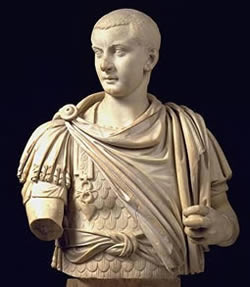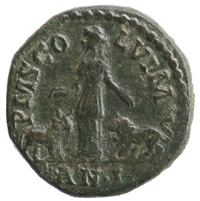Viminacium introduction
Viminacium was an important Roman city with an army base in the province of Moesia Superior. Since 91 AD it was the homebase of the legio VII Claudia Pia Fidelis. The remnants of the city are now situated in todays Serbia. The army base in Viminacium was founded during the 1st century AD during the Roman operations to secure the border along the Danube river. With the arriving of the legio VII Claudia Pia Fidelis and IV Flavia in the 2nd half of the first century, a beginning was made to erect a stone camp instead of a wooden one. After that Viminacium began to grow into a town that received the status of municipium during the reign of the emperor Hadrian in 117. Inscriptions show the  name of the town as MVNICIPIVM AELIVM VIMINACIVM. In the reign of the emperor Gordian III (238-244) the city received the status of COLONIA. This probably took place between july and october 239. The emperor Gordian was probably there at the time of the promotion. The promotion of the city to a colony had probably something to do with the 1 year aniversary of Gordians reign. The promotion gave the inhabitants Roman civil rights but as an extra honour Gordian gave the colony the right to mint coins. The coins struck in this mint bear Latin legends in contrary to other provincial Roman mints whose coins almost all bear Greek legends. The Latin legends make them more interesting and accessible to collectors than those with Greek legends.
name of the town as MVNICIPIVM AELIVM VIMINACIVM. In the reign of the emperor Gordian III (238-244) the city received the status of COLONIA. This probably took place between july and october 239. The emperor Gordian was probably there at the time of the promotion. The promotion of the city to a colony had probably something to do with the 1 year aniversary of Gordians reign. The promotion gave the inhabitants Roman civil rights but as an extra honour Gordian gave the colony the right to mint coins. The coins struck in this mint bear Latin legends in contrary to other provincial Roman mints whose coins almost all bear Greek legends. The Latin legends make them more interesting and accessible to collectors than those with Greek legends.
The main coinage took place in the form of copper and brass coins in the form of asses, dupondi and sestertii. The mint also produced some antoniniani, probably as early as the reign of Philip the Arab. The AE coins, as the copper and brass coins often are refered to, of Viminacium are easy to recognize. The reverse of the coins show a woman who is seen as the personification of the province of Moesia Superior. On her left side stands a bull, the emblem of the legio VII, and on her right side stands a lion. The lion was the emblem of the legio IIII Flavia Felix. This legion was also stationed in Moesia Superior, first in Viminacium together with the legio VII Claudia Pia Fidelis but was transfered around 91 AD to the city of Sin- gidunum, modern Belgrade. The reverse legend is almost always PMS COL VIM which can be explained as PROVINCIA MOESIA SUPERIOR COLONIA VIMINACIUM. In the exergue on the reverse of the coins stands AN (ANNO) followed by a Roman numeral. This numeral stands for the local year in which the coin was struck. The year I stands for the first year after the date the city of Viminacium was promoted to a colony and a mint was erected. This year one covered the period of the first day of the promotion until the same date in the following year. The year I can thus be indicated as 239/240. The year II as 240/241 and so on.
gidunum, modern Belgrade. The reverse legend is almost always PMS COL VIM which can be explained as PROVINCIA MOESIA SUPERIOR COLONIA VIMINACIUM. In the exergue on the reverse of the coins stands AN (ANNO) followed by a Roman numeral. This numeral stands for the local year in which the coin was struck. The year I stands for the first year after the date the city of Viminacium was promoted to a colony and a mint was erected. This year one covered the period of the first day of the promotion until the same date in the following year. The year I can thus be indicated as 239/240. The year II as 240/241 and so on.
The precise date of the beginning of the local year is not known. Some scholars assumed it started on january 1st, simultaneously with the new consular year. This date however gives many problems with the known chronology of the emperors. Also april 1st, the date of the founding of the city of Rome, gives too many problems with this chronology. However this time reckoning must have been in use in the province of Moesia Superior because on one type of antoninianus of the usurper Pacatian the year ANNO MIL ET PRIMO is mentioned. When this very rare time reckoning was used at all it was based on the date of the foundation of the city of Rome. In the 3th century AD this date was set on april 1st following the calculations of Varro. The time reckoning of the colonia Viminacium itself as used on the coins must have been based on an other date. Nowadays many scholars assume that this date was october 1st. I think this date is a little too late, i prefer a date between july 1st and august 1st. It is highly possible that the mint did not held strict control over this date. The new local year on the coins could have been used a little bit later or a little sooner. It is also highly probable that old reverse dies could have been used in combination with newer obverse dies of successive emperors.
| ANNO: | Period |
| I | july 239 - july 240 |
| II | july 240 - july 241 |
| III | july 241 - july 242 |
| IIII | july 242 - july 243 |
| V | july 243 - july 244 |
| VI | july 244 - july 245 |
| VII | july 245 - july 246 |
| VIII | july 246 - july 247 |
| VIIII | july 247 - july 248 |
| X | july 248 - july 249 |
| XI | july 249 - july 250 |
| XII | july 250 - july 251 |
| XIII | july 251 - july 252 |
| XIV | july 252 - july 253 |
| XV | july 253 - july 254 |
| XVI | july 254 - july 255 |
According to the Roman numerals of the local year in the exergue on the reverse of the coins the mint of Viminacium produced copper and brass coins until the local year XVI (254/255). However, during the reign of Valerian (253-260) and his son Gallienus (253-268) the coinage of silver antoniniani could have lasted until the year 257/258. In that year the mint was closed, maybe after the revolt of Ingenuus, a general who wanted to tumble the reign of Gallienus. In this web catalog many coins of the Viminacium mint are displayed. Many more variants exist but could not yet been displayed by the lack of images of those coins.